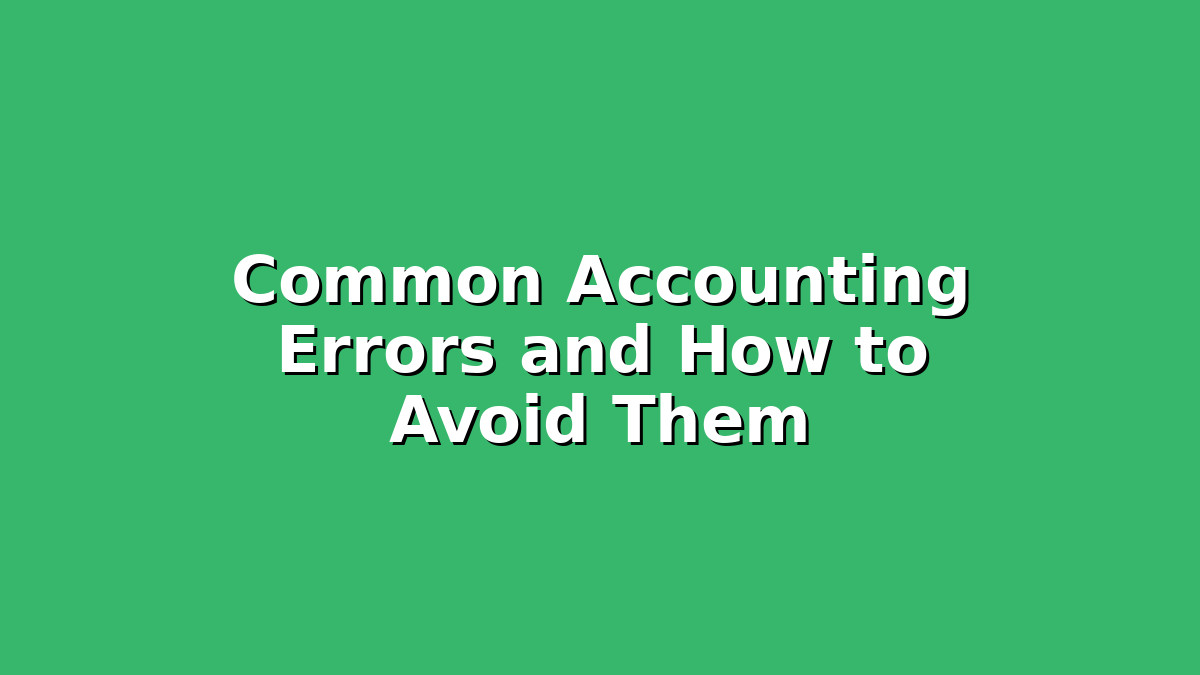Accounting is a fundamental subject for many students, especially those pursuing careers in finance, business, or economics. Whether you are preparing for your exams or simply looking to strengthen your understanding, mastering accounting principles and practices is essential. However, errors are common, especially when you’re learning complex concepts and handling multiple transactions. Recognizing the most frequent accounting mistakes and knowing how to avoid them can boost your confidence and improve your accuracy during exams and practical assignments.
In this article, we’ll explore some common accounting errors students face and provide practical study tips and strategies to help you avoid these pitfalls. By understanding these challenges, you’ll be better equipped to tackle your coursework and excel in your accounting exams.
1. Misclassification of Accounts: Understanding the Basics
One of the most frequent errors students make is misclassifying accounts. This occurs when transactions are recorded under incorrect account categories, which can distort financial statements and lead to inaccurate results.
Why It Happens:
Accounting involves categorizing transactions into assets, liabilities, equity, revenues, or expenses. Students who are still getting familiar with these categories might confuse similar accounts or forget which accounts belong to which category. For example, recording a purchase of office supplies as an asset instead of an expense is a classic misclassification error.
How to Avoid It:
– Master the Accounting Equation: Make sure you have a strong grasp of the fundamental accounting equation (Assets = Liabilities + Equity). Understanding how each transaction affects this equation will guide you in correctly classifying accounts.
– Use Account Grouping Charts: Create or use standard charts of accounts during your studies. These charts visually group accounts by type and can help reinforce which transactions belong where.
– Practice with Real-Life Examples: Try to relate your practice exercises to real-world scenarios. For instance, ask yourself, “Is this purchase a one-time asset or a recurring expense?” This contextual understanding helps solidify account classification.
– Review After Recording: After you complete journal entries, review each one to ensure accounts are properly classified. This habit will make you more mindful and reduce careless mistakes.
2. Errors in Calculation: Double-Check Your Math
Accounting is math-intensive, and simple errors like addition mistakes or incorrect totals can throw off your entire workbook. Calculation errors are especially common under exam pressure when students rush.
Why It Happens:
Stress, fatigue, or rushing through homework or exam questions can lead to overlooking small calculation details. Using incorrect formulas or mixing up numbers during addition or subtraction are typical missteps.
How to Avoid It:
– Slow Down and Stay Organized: Allocate specific time to check calculations carefully. Write out your math clearly and avoid cramming multiple steps into a single line.
– Use Calculator Wisely: While calculators are useful, don’t rely on them blindly. Always double-check results manually or by recalculating the problem in a different way.
– Break Problems Into Steps: Divide complex problems into smaller parts. For example, calculate totals before tax, then add tax separately, and finally compute the grand total. This reduces overwhelming the brain and decreases the chance for errors.
– Practice Mental Math and Estimation: Build your number sense by estimating answers before calculating. This helps you recognize when a calculated answer is unreasonable, so you can recheck it immediately.
– Review Your Work Backwards: After finishing calculations, try reviewing numbers backward (from the last figure to the first) to catch errors that may have slipped in during the initial process.
3. Ignoring Adjusting Entries and Reconciliations
Adjusting entries and reconciliations are essential parts of accounting that ensure financial statements reflect the true financial position. Many students overlook or misunderstand these, leading to incomplete or inaccurate records.
Why It Happens:
Adjusting entries are often taught later in accounting courses and can seem complicated, involving accruals, deferrals, depreciation, and more. Students may skip these sections or fail to practice enough, resulting in missed or incorrect adjustments.
How to Avoid It:
– Understand the Purpose of Adjustments: Know that adjusting entries correct timing differences between revenue and expenses and ensure accounts are accurate at the end of an accounting period.
– Create a Checklist: When working on practice problems or exam questions, have a checklist reminding you to prepare adjusting entries for accrued expenses, prepaid expenses, depreciation, and unearned revenues.
– Practice Regularly: The more you practice adjusting entries, the more comfortable you will become. Use sample questions, flashcards, and past exam papers to reinforce your understanding.
– Learn to Reconcile Accounts: Reconciliation means comparing your records with bank statements or other external documents. Practicing bank reconciliations will help you spot discrepancies early and understand how to correct them.
– Seek Help When Needed: If you find adjusting entries difficult, don’t hesitate to ask teachers, join study groups, or watch online tutorials. Sometimes a different explanation can clarify complex concepts.
Conclusion
Accounting may seem challenging at first, but with the right approach to studying and attention to common errors, you can master it effectively. Misclassifying accounts, making calculation mistakes, and overlooking adjusting entries are some of the most common errors students encounter. However, by strengthening your understanding of accounting principles, staying organized, practicing regularly, and reviewing your work carefully, you can significantly reduce these mistakes.
Remember, errors are part of the learning process. Each mistake you identify and correct brings you one step closer to becoming confident and proficient in accounting. Keep practicing, stay patient, and approach your accounting exams with a clear strategy. With consistent effort and smart study habits, you will succeed!
Good luck with your studies!

Responses